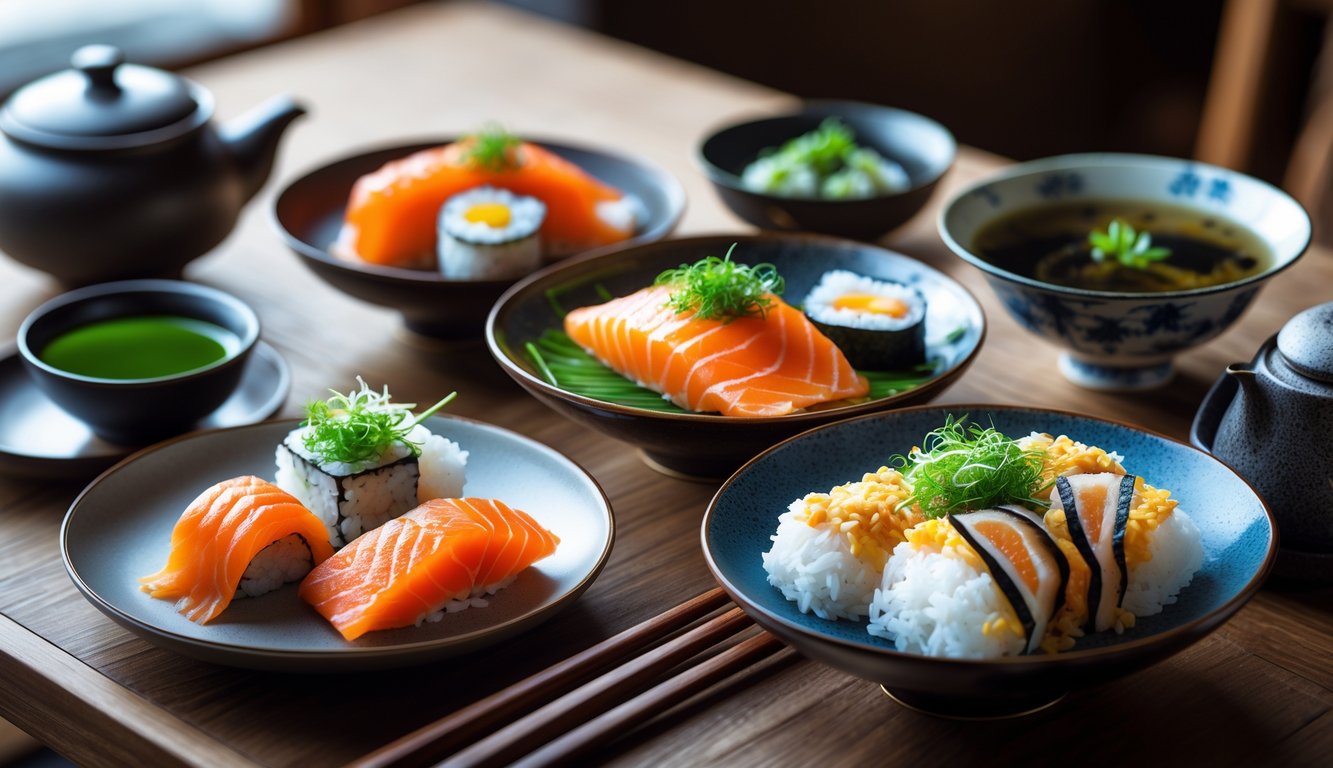
Sweets, Drinks, And The Finishing Touch
So here I am, poking at the dessert situation, and it’s not about skipping sweets because you’re full—it’s just…different. That last slurp of matcha or bite of mochi? Suddenly I’m rethinking what “finished” even means.
Traditional Japanese Desserts
Ever had wagashi? Those tiny, shiny things that look like jewelry? I bit into one expecting cupcake-level sugar, and nope—just this super subtle, almost shy sweetness. Bean paste, chestnut, rice. The pastry chef’s there, piping sakura petals like it’s an art project, and I’m standing there thinking, “Am I eating this wrong?”
Mochi’s gone global—sometimes it’s ice cream, sometimes it’s just chewy and confusing—but here, the classics still rule at tea ceremonies and New Year. The top wagashi are barely sweet at all. My Kyoto friend (she’s a dietitian, so she’d know) swears you can eat three and still call it a light snack.
Honestly, the first time I bit into dorayaki, expecting fudge, and got bean paste? I almost cried.
Role Of Sake And Tea
Just when you think you’re done, someone’s pouring sake into a thimble-sized glass. My old teacher told me, “Sip, don’t chug.” Never works—sake’s sneaky. Sometimes it’s floral, sometimes it’s like drinking warm silk, and half the time I can’t tell the grades apart.
Pairings get weirdly specific—sake with sashimi, dried roe, whatever’s salty. Then there’s matcha, whisked until it’s mostly foam. The Japanese Tea Association says a bowl has about 70 mg of caffeine, but somehow you don’t get twitchy. L-theanine or magic? No clue.
Drinks here aren’t just about quenching thirst. I always screw up the tea-to-sweets thing, but someone quietly tops off my cup anyway, like they’re used to clueless foreigners.
Cleansing The Palate
If there’s a reset button at the table, palate cleansers are it. Not sure if it’s about boredom or just erasing the last flavor, but I’m always thrown off. It’s not like lemon sorbet after steak—think pickled ginger, salty umeboshi, a wedge of melon that’s so watery it feels like starting over.
Sometimes it’s just hot barley tea. Zero calories, weirdly soothing. I read in The Japanese Culinary Companion that palate cleansers aren’t about hiding mistakes—they’re about making you notice the shift, even if you’re just trying to forget that last bite of natto. Half the time I finish, I’m not sure if I want dessert or another round of pickles.
Here’s what I actually ate between courses, plus what went through my head:
| Cleansing Bite | What I Imagined |
|---|---|
| Pickled Daikon | “Are we done now?” |
| Sliver of Melon | “Is dessert next?” |
| Hot Barley Tea | “Did I eat too much?” |
| Salted Sakura Leaf | “Am I supposed to eat this or stare at it?” |
Seriously, the salted leaf still baffles me.
Frequently Asked Questions
You’d think dinner is just rice and fish, but there’s always one random thing on the tray that messes with your expectations. Pickled plums, miso soup that lingers, whatever. Most of the magic’s in the obsession with balance, umami, and this almost irritating precision—razor-sharp knives, tofu that’s basically a cloud, and these tiny flavor bombs of salt or sugar.
What’s the secret ingredient that makes Japanese meals incredibly satisfying?
I spent ages thinking it was MSG or some chef’s secret handshake, but apparently it’s just relentless ingredient freshness. Tokyo supermarkets have daikon so white it looks photoshopped, and you can tell it was picked that week. Fresh, high-quality ingredients make everything taste both subtle and, somehow, loud. I keep complaining about expensive fish but it never gets less essential.
How does the concept of umami contribute to a fulfilling Japanese dining experience?
Every chef and cookbook author here won’t shut up about umami, but most people have no idea they’re even chasing it. Glutamates in miso, dashi, soy sauce—suddenly your soup’s in the same league as a parmesan-loaded pasta, just…with rice. Tried to explain umami once, just pointed at my empty bowl and shrugged. Science says, “Umami intensifies satiety cues and depth of flavor in protein-rich broths” (Kumagai, 2021, Journal of Nutritional Science). Sure, I guess.
Can you explain why Japanese cuisine is often considered healthier than other cuisines?
Honestly, “healthy” is such a moving target, but it’s hard to argue with the facts. Most meals—bento, izakaya, whatever—are heavy on veggies, grilled fish, fermented stuff, and barely any processed sugar. The British Dietetic Association (2024) says Japanese dinners are about 40% lower in calories than typical Western fast food. Nutrient density and small portions mean you basically can’t overeat, unless you’re trying.
What are the traditional Japanese food preparation methods that enhance the dining experience?
Knife skills here are on another level. Watching a chef peel a cucumber in four moves is both hypnotic and, honestly, kind of infuriating. Tempura? The chef’s controlling oil temp with chopsticks like it’s a science fair, and my own attempts always turn into greasy sadness. Teriyaki chicken? You have to let it rest, layer the sauce, wait for the glaze—rush it and you’ll miss that umami glow everyone’s obsessed with.
Why do people say that eating Japanese food can be a surprisingly fulfilling sensory experience?
You know those trays with five tiny bowls, not a plate in sight, and suddenly you’re Instagramming pickled eggplant? My cousin once refused to eat something because it looked too pretty, which, yeah, is apparently a thing in Kyoto omakase spots. Every meal turns into this weird exercise in color and texture, and I still don’t get why Westerners barely notice the little bowls of tart radish until halfway through. It’s not random—these aesthetic “rules” go back centuries, and every bite ends up being a whole sensory trip, even if you weren’t hungry. For more, here’s a cultural rabbit hole on Japanese communal meals.
How does the balance of flavors in Japanese dishes lead to a more satisfying meal?
Seriously, why can’t they just slather sauce over the fish like everyone else? But nope, every piece gets its own weird little sidekick—wasabi, a dab of pickled radish, or that shredded ginger I always forget the name of. And then it’s not just salty or sweet, it’s like, sweet and sharp and sour and salty and sometimes bitter, all crammed onto this tiny plate. Last time I ended up at some izakaya, people were straight-up arguing about soy sauce, like, “Don’t add more, you’ll ruin the balance!” Is that even a thing? Apparently, yeah—some study in the Journal of Gastronomy (Ishii, 2022) claims mixing flavors keeps you from getting bored and somehow makes you eat slower. Supposedly, it’s more satisfying that way. I don’t know, maybe there’s something to it, but I still want to dump extra sauce on everything.



